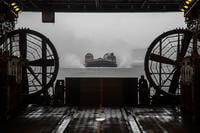Would Congress or the Pentagon take away the Marine Corps' ability to fly fast jets from big-deck amphibious ships?
It seems inconceivable, but that's what would happen if DoD canceled the Marines' F-35B Lightning II -- and that's probably why it was never actually a serious option. The service's AV-8B Harriers are wearing out, and there's no time or money to opt for anything else besides the B. But the B had its high profile, well-documented development problems, and to show he meant business, former Secretary Gates put the jet "on probation," warning that unless it got it act together ... something ... might happen to it. (Nothing was going to happen to it.)
Program officials today say they've got the B's problems just about licked, and now the key is to try to restore the jet's good name -- or give it one in the first place. To that end, the Marines on Friday flew a group of reporters -- sadly, not including your correspondent -- from the Pentagon to Naval Air Station Pax River aboard an MV-22 so they could watch a B doing its thing. Marine Commandant Gen. James Amos told them, and an industry audience this week, that he is confident the B can get off "probation" as soon as Secretary Panetta gets the full picture of how far the program has come, with all its many short takeoffs and vertical landings. It wouldn't be surprising if the B is taken off "probation" before or just after its planned shipboard tests this fall aboard the amphibious assault ship USS Wasp. Not only that, if the Marines can demonstrate the jet works as advertised, they'll have a leg up on the Navy -- its C-model isn't supposed to fly on and off a carrier until 2013.
Amos and other top Marine Corps officials say the country is getting a great deal with the Bs and Cs: When they're in service, it'll be the first time in decades that the naval services can operate the same frontline fighter from all the fleet's different flight decks, Cs from full-sized, nuclear-powered carriers and B from smaller, conventional LHDs and LHAs. That means tomorrow's stealthy Marine squadrons could take first-day-of-the-war missions that Harrier squadrons never could. And that, Amos argues, effectively doubles the number of capital ships in the U.S. fleet -- assuming the Navy doesn't lose some to the Mother of All Reviews or a last-minute debt ceiling bargain.







